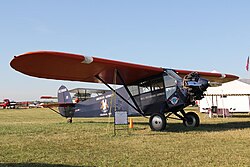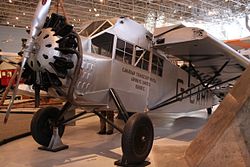Fairchild FC-2
| Fairchild FC-2 | |
|---|---|
 a restored Fairchild FC-2 |
|
| Type: | single-engine multipurpose aircraft |
| Design country: | |
| Manufacturer: | |
| First flight: |
Mid-1926 (prototype FC-1) |
| Commissioning: |
1927 |
| Production time: |
1927 to 1928 |
| Number of pieces: |
about 150 |
The Fairchild FC-2 was a five-seat multi-purpose aircraft and also the first mass-produced aircraft type by the American manufacturer Fairchild Aircraft Manufacturing Company .
history

In 1917, Sherman Fairchild won a government contract to develop a camera for aerial reconnaissance , which was not ready for series production until after the First World War . The US armed forces placed a follow-up order in 1920, which resulted in Sherman Fairchild's first company, the Fairchild Aerial Camera Corporation . In the early 1920s, Fairchild Aerial Camera also carried out civil survey flights with former military aircraft and took completed aerial photographs . Because the double-deckers used did not meet his requirements, Sherman Fairchild designed the model of a high-decker with a heated and glazed cabin, which offered more protection from the weather and gave the photographer a better view downwards through the wings above the cabin . After presenting his design to several aircraft manufacturers, Fairchild concluded that it would be more effective and cheaper to produce it in-house. To this end, he built his first aircraft factory in Farmingdale ( Long Island ).
The prototype, known as FC-1 (derived from F airchild C abin), completed its maiden flight in mid-1926. The machine had a cabin designed for a maximum of three people, the windows of which could be opened for photo purposes. The machine was powered by an eight-cylinder Curtiss OX-5 engine that developed 90 hp (67 kW). At that time, the first postal airlines had started operating on the privatized CAM routes . These companies sometimes also carried passengers in their double-deckers, with the passengers having to sit on the mailbags. Sherman Fairchild decided to modify the prototype so that it could be used to carry four passengers and / or cargo. For this purpose, the cabin was enlarged and a 200 hp (149 kW) nine- cylinder Wright J-4 radial engine was installed. The modified prototype was named FC-1A .
From the FC-1A the serial version FC-2 emerged in 1927 . This aircraft was offered as standard with a Wright J-5 engine of the same power (a J-4 with modified cylinder heads) and was optionally available with a water-cooled six-cylinder in-line Curtiss C-6 Challenger engine, the 160 PS (119 kW ) performed. This version was called FC-2C ( C hallenger ) and was only ordered in small numbers by Curtiss Flying Service .
From the beginning of June 1927 to the end of February 1928 a total of 56 machines of the type FC-2 were manufactured by Fairchild , another 12 under license from Canadian Vickers in Montreal . Customers included Clifford Ball Airline , Colonial Airways and Pan American-Grace Airways . The factory also offered versions with snow runners, of which the Royal Canadian Air Force acquired fourteen machines in autumn 1927, as well as a version with floats, with which Pan American Airways began its mail service to Havana on October 19, 1927 .
The FC-2W ( W asp ) and the FC-2W2 with an enlarged cab were offered from spring 1928. These versions had a nine-cylinder radial engine of the Pratt & Whitney R-1340 Wasp with an output of 400 hp (298 kW) and were thus twice as powerful as the original FC-2. Well-known aircraft of this series were the FC-2W "Spirit of New York" , with which Charles Collyer and John H. Mears circled the earth in 23 days and 15 hours in the summer of 1928 and thus set a new record, as well as one on the name " The Stars and Stripes “ FC-2W2, with which Admiral Richard Evelyn Byrd began his first South Pole expedition in the same year , with the machine also being used on a rescue mission in Antarctica . The plane was stored in an igloo at the end of the expedition and returned to the USA in 1935.
construction
The Fairchild FC-2 was designed as a high- wing aircraft with braced wings . It had a rigid main landing gear with a tail spur. By default, the aircraft by a 149 kW (290 hp) was Neunzylinder- radial engine of the type Wright J-5 driven. The closed and heated cabin offered space for a pilot and four passengers, whose seats were arranged in pairs one behind the other.
The hull of all versions consisted of a welded tubular steel construction with fabric covering. In the FC-2 and FC-2W, two wider and one narrower main spar formed the metal frame of the cabin, the walls of which were clad with wood on the inside. Due to their triangular cabin shape, the machines in Canada were also known as "Razorback" . The later version FC-2W2 had a fuselage stretched by 56 cm with an enlarged cabin, the base frame of which was made up of four spars. Two more passenger seats were installed in the interior protruding beyond the wing root, so that this type had four instead of three side windows.
The wings, including the wing spars and the planking, were made entirely of wood in all versions and covered with a layer of fabric. They could be folded back sideways, so that the aircraft could also be parked in smaller hangars .
Versions
Factory series
- FC-1
- Prototype of a three-seater cabin aircraft for aerial photography and land surveying , equipped with a 90 hp (67 kW) eight-cylinder Curtiss OX-5 engine .
- FC-1A
- converted FC-1 prototype with an enlarged cabin and a nine-cylinder radial engine of the Wright J-4 type, which delivered 200 hp (149 kW).
- FC-2
- five-seat passenger aircraft based on the FC-1A, powered by a 200 hp (149 kW) nine-cylinder radial engine of the improved Wright J-5 type , 56 aircraft manufactured and 12 licensed buildings in Canada.
- FC-2C
- identical to the FC-2, but with a 160 hp (119 kW) six-cylinder in-line Curtiss C-6 Challenger engine .
- FC-2W
- FC-2 based transport aircraft for passenger or cargo transportation, also referred to as FC-2-W1; the version had extended wings with a wingspan of 15.39 m (50 feet ), modified ailerons and a nine-cylinder radial engine of the Pratt & Whitney R-1340 Wasp , which developed 400 hp (298 kW), approx. 50 aircraft manufactured, including six for the Royal Canadian Air Force ( RCAF ).
- FC-2W2
- based on the FC-2W, the multi-role aircraft had a fuselage extended from 9.45 m to 10.01 m and an enlarged cabin for six passengers. The seats could be removed quickly to carry cargo. From this version, later also referred to as Fairchild 61 , the Fairchild 71 emerged in the spring of 1928 .
Conversions and other designations
- C-96
- Designation for three FC-2W2s requisitioned for transport by the United States Army Air Forces ( USAAF ) in 1942.
- UC-96
- USAAF designation used from 1943 for the C-96.
- XJQ-1
- Name of the US Navy for an FC-2 acquired for military testing.
- XJQ-2
- Retrofitting of the XJQ-1 with a nine-cylinder radial engine of the Pratt & Whitney R-985 type , which delivered 450 HP (336kW); the machine was later also referred to as the XRQ-2 .
- FC-2L
- planned designation for six FC-2 of the RCAF , which in 1930 were to receive 215 HP strong Armstrong Siddeley Lynx engines , the project was abandoned in favor of the Fairchild 51.
- Fairchild 51
- from the RCAF -commissioned remodeling their FC-2; the machines received, among other things, modified ailerons, the enlarged cabin of the FC-2W2 and engines of the Wright J-6; six conversions were carried out by the Fairchild plant in Longueuil ( Canada ) from July 1930 .
- Fairchild 51A
- three conversions according to the Fairchild 51, but with Pratt & Whitney R-985 Wasp Junior engines .
Technical specifications of the Fairchild FC-2
| Parameter | Data |
|---|---|
| crew | 1 |
| Passengers | 4th |
| length | 9.45 m |
| span | 13.41 m |
| height | 2.74 m |
| Wing area | 26.94 m² |
| Empty mass | 980 kg |
| Max. Takeoff mass | 1633 kg |
| Cruising speed | 169 km / h |
| Top speed | 196 km / h |
| Service ceiling | 3505 m |
| Range | 1127 km |
| Engines | a Wright J-5 Whirlwind nine-cylinder radial engine with 149 kW (200 PS) |
See also
Web links
Individual evidence
- ↑ a b c d e f g h i j k l m n o p q r Aero, edition 73, year 1984
- ↑ CAHC - Montreal's aviation museum, Fairchild FC-2 Razorback (1927)
- ↑ Ed Coates' Civil Aircraft Photograph Collection, Colonial Western Airways, Fairchild FC-2, 5508 (c / n 109)
- ↑ Ed Coates' Civil Aircraft Photograph Collection, West Indian Aerial Express, Fairchild FC-2, 1654 (c / n 15)
- ↑ Flint Whitlock, Terry L. Barnhart: Capt. Jepp and the Little Black Book . Savage Press, Superior 2007, ISBN 1-886028-83-4 .
- ↑ Fairchild FC-2W2 NC8006
- ^ Smithsonian National Air and Space Museum, Fairchild FC-2W2
- ^ EAA Museum, 1927 Fairchild FC-2 W2 - NC3569
- ^ A b Royal Aviation Museum of Western Canada, Fairchild Razorback, G-CYWU
- ^ Canadian Aviation Historical Society, Aviation Museum Completes First Historical Airplane Replica ( Memento from December 30, 2015 in the Internet Archive )
- ↑ a b c d e Bernard Shaw: Photographing Canada from Flying Canoes . General Store Publishing House, Burnstown 2001, ISBN 1-894263-42-1 .
- ↑ Full scale drag tests on various parts of Fairchild (FC-2W2) cabin monoplane
- ^ National Air and Space Archives, Fairchild Industries, Inc.



